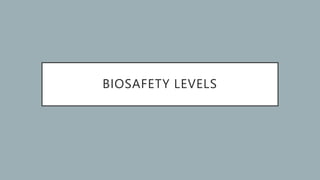
Biosafety Levels .pptx
- 2. Biological safety levels — often abbreviated to biosafety levels or BSL — are a series of protections specific to autoclave-related activities that take place in biological labs. Biosafety levels are individual safeguards designed to protect laboratory personnel, as well as the surrounding environment and community. These levels, which are ranked from one to four, are designated based on the agents or organisms laboratory personnel are researching or working on. For example, a basic lab setting that specializes in the research of non-lethal agents that pose minimal threat to lab workers and the environment would generally be considered BS-1, which is the lowest biosafety level. By way of comparison, a research laboratory that specializes in handling potentially deadly infectious agents, such as the Ebola virus, would be designated as a BSL-4 lab — the highest and most stringent biosafety level.
- 3. BSL defined as to indicate what specific controls a laboratory must have in place for the containment of microbes and biological agents Each biosafety level — BSL-1 through BSL-4 — is defined based on the following: Risks related to containment Severity of infection Transmissibility Nature of the work conducted within the lab Origin of the microbe Route of exposure Biosafety levels dictate the types of work practices allowed to take place in a lab setting; they also heavily influence the overall design of a facility and the type of specialized safety equipment in it
- 4. BIOSAFETY LEVEL 1 (BSL-1)
- 5. The lowest of the four biosafety levels, biosafety level 1 (BSL-1) applies to laboratory settings in which personnel work with low-risk microbes that pose little to no threat of infection in healthy adults for example, a BSL-1 laboratory might work with a nonpathogenic strain of E.coli. BSL-1 labs typically conduct research on benches do not use special contaminant equipment, and do not need to be isolated from surrounding facilities. BSL-1 labs also require immediate decontamination after spills. Infectious materials should also be decontaminated prior to disposal, generally through the use of an autoclave
- 6. Safety protocols for biosafety level 1 labs — which require only standard microbial practices — include: Mechanical pipetting (no mouth pipetting allowed) Safe sharps handling Avoidance of splashes or aerosols Daily decontamination of all work surfaces when work is complete Regular handwashing Prohibition of food, drink, and smoking materials The use of personal protective equipment (PPE), such as goggles, gloves, and a lab coat or gown Biohazard signs
- 7. BIOSAFETY LEVEL 2 (BSL-2)
- 8. Biosafety level 2 (BSL-2) covers all laboratories that work with agents associated with human diseases that is, pathogenic or infectious organisms, that pose a moderate health hazard examples of agents found in a BSL-2 lab include equine encephalitis viruses, HIV, and staphylococcus aureus (staph infections BSL-2 labs are required to maintain the same standard microbial practices as BSL-1 labs, as well as enhanced measures due to the potential risk Personnel working in biosafety level 2 laboratories are expected to take even greater care to prevent injuries, such as cuts and other breakage to the skin, as well as ingestion and mucous membrane exposures
- 9. BSL-2 labs are subject to the following safety controls: The use of PPE, including lab coats, gloves, eye protection, and — in some cases — face shields All procedures that could cause infection from aerosols or splashes must be performed within a biological safety cabinet. Decontamination of infectious materials prior to disposal, generally through the use of an autoclave Self-closing, lockable doors Access to a sink and eyewash station Biohazard warning signs Access to a biosafety level 2 lab is far more restrictive than to a biosafety level 1 lab. Outside personnel, or those with an increased risk of contamination, are often restricted from entering the area while work is underway
- 10. BIOSAFETY LEVEL 3 (BSL-3)
- 11. a biosafety level 3 (BSL-3) laboratory typically conducts research into or work on microbes that are either indigenous or exotic and can cause serious or potentially lethal disease through inhalation. Common examples of microbes found in BSL-3 labs include yellow fever, West Nile virus, and the bacteria that causes tuberculosis. Microbes found within biosafety level 3 settings are so serious that work is often strictly controlled and registered through the appropriate government agencies Laboratory personnel are also under medical surveillance and may require immunizations for the microbes they work with.
- 12. Common safety controls within a BSL-3 lab include: The use of PPE, including goggles and gloves; respirators may also be required The use of solid-front wraparound gowns, scrub suits, and/or coveralls is often required Access to a hands-free sink and eyewash station available near the exit Sustained directional airflow to draw air into the laboratory from clean areas toward potentially contaminated areas (exhaust air cannot be recirculated) Self-closing set of locking doors with access away from general building corridors Access to a BSL-3 laboratory is restricted and controlled at all times.
- 13. BIOSAFETY LEVEL 4 (BSL-4)
- 14. Biosafety level 4 (BSL-4) labs are rare; however, a small number exist in the U.S. and around the world. As the highest level of biological safety, BSL-4 labs work with highly dangerous and exotic microbes, such as the Ebola and Marburg viruses (zoonotic virus). Infections caused by these types of microbes are often fatal and come without treatment or vaccines.
- 15. biosafety level 4 laboratories must follow these safety protocols: Personnel must change clothing before entering the facility and shower upon exiting All materials must be decontaminated before leaving the facility Personnel must wear the PPE from lower BSL levels, as well as a full-body, air-supplied, positive pressure suit Access to a Class III biological safety cabinet BSL-4 labs are extremely isolated, often located in an isolated and restricted zone of a building or in a separate building entirely. BSL-4 labs also feature a dedicated supply of exhaust air, as well as vacuum lines and decontamination systems.